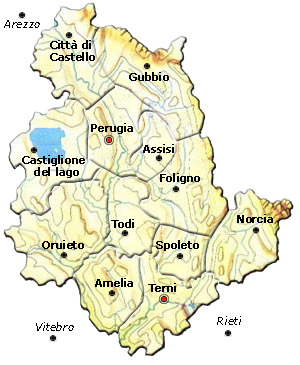Umbria #3: Where and what
Snap above is on the country road in the hilly Tiber Valley driving from Todi to Montefalco, with the charming town of Todi in the distance, on the hill. Italy is good about having a sharp distinction between town and country. Little-to-no sprawl. Except in the big cities, you go from urban density directly to vineyards, olive groves, or forests full of deer, cinghiale, eagles, even wolves and, best of all, the ferocious and dangerously-expensive Wild Black Truffle. People like to live in towns, where they can walk to work and shop, and can say bon giorno to their neighbors.

Bit of history
A quick history and geography of Umbria in central Italy, northeast of Rome, to put my forthcoming travel pics in context. It is generally similar to the history of the entire area we now term Italy.
Central Italy was the prehistoric land of the Etruscans (hence "Tuscany" - land of the Etruscans) and of the less-known Umbri. They were, relatively speaking, peaceful and prosperous farmers and traders. When Rome began its imperial expansion around 250 BC, Umbria up along the old trading route to the Adriatic (which the Romans later termed the Via Flaminia) seemed like an obvious target.
The Romans did their Roman thing there for 600 years until the empire began to unwind and Goths and Lombards moved into Tuscany and Umbria both by immigration and by arms in the 400s-500s. In many ways, these waves of invasion became sort of Romanized and Christianized, in time. The Byzantines were in the mix then, too.
Warring feudal duchys and kingdoms dominated the dark ages in this part of Italy, during a time when the declining Roman regions were also set upon by piratical Saracens (mainly seeking slaves for the Middle Eastern slave trade) and Normans (seeking adventure), until Papal power exerted itself and built an authoritarian, theocratic peace by the 1100s and 1200s. They were big on building castles with which to assert their powerful churchly presence, but from the days of the late empire people were building their own keeps and walls to defend themselves from foreigners and also from their neighboring towns. The Roman Legions had previously made walls and keeps unnecessary: the Roman armies had been the wall. The Pax Romana.
The Papal State pretty much controlled central Italy, perhaps to its detriment, until the Italian nation was invented 150 years ago. Roman Catholicism was pretty much corrupted by money and politics, during that era, including the Benedictines.
2011 is the 150th anniversary of that political event. Garibaldi, etc.
Geography
Geographically, southern Umbria divides itself into three regions: The north-south-running Tiber Valley where the Tiber flows south towards Rome, the fertile north-south running Valle Umbra which is like a mini version of California's Central Valley, and the eastern Valnerina which is the area in the majestic Appennines where the river Nera flows down to eventually join and magnify the Tiber.
We visited and stayed in incredible hotels in each of those three areas of Umbria. As in Roman times, rural and quaint Umbria is a popular Roman getaway place, full of bikers, motorcyclists, foodies, and hikers. It's only a 2 or 3 hour drive from Rome, and it is packed with "unspoiled gems."
Most of the towns were Umbrian first, Roman later, and then Medieval-Renaissance. Except for towns damaged by the war (like Terni) or by earthquakes (like Foligno), there is a lot of Renaissance, generally built on Medieval town footprints.
Except for Assisi with its bus-loads of pilgrims, we saw few non-Italian tourists and only one American couple - friendly folks from Montgomery, Alabama! Some Brits, Aussies, Austrians, and Dutch. We tend to meet people when we travel. That's part of the fun.

Todi, Amelia, Orvieto, Montefalco, and Perugia are on hills in the Tiber Valley. Towns in Umbria tended to be built on hills for defensive purposes, which is why exploring Italy is such a good physical workout. Assisi, Spoleto, Spello, and Terni are along the western edge of the Apennines where they rise from the plain. Norcia, and our monastery hotel, are in the mountains themselves near where the Nera emerges from the mountains.
Weather
Best times for Italy or any Mediterranean travel are Spring and Fall. May and October are perfect. Italy climate here.
I will have lots more fun travel pics soon - Pic below of the Valle Umbra, looking west from the Assisi hillside:
Pic below from the garden of our 6th C. Benedictine monastery hotel in the Valnerina in the Apennines, with a small hillside olive grove (doubling as parking area) below the wall. It is no wonder that people love to visit Italy: it has the food, the history, the scenery, the quaintness, the vino, the art and architecture, and the delightfully tough and fashionable Italian gals.
Posted by Bird Dog in History, The Culture, "Culture," Pop Culture and Recreation at 12:00 | Comments (3) | Trackbacks (0)
QQQ
"The marvel of all history is the patience with which men and women submit to burdens unnecessarily laid upon them by their governments."
George Washington
No comments:
Post a Comment
Note: Only a member of this blog may post a comment.